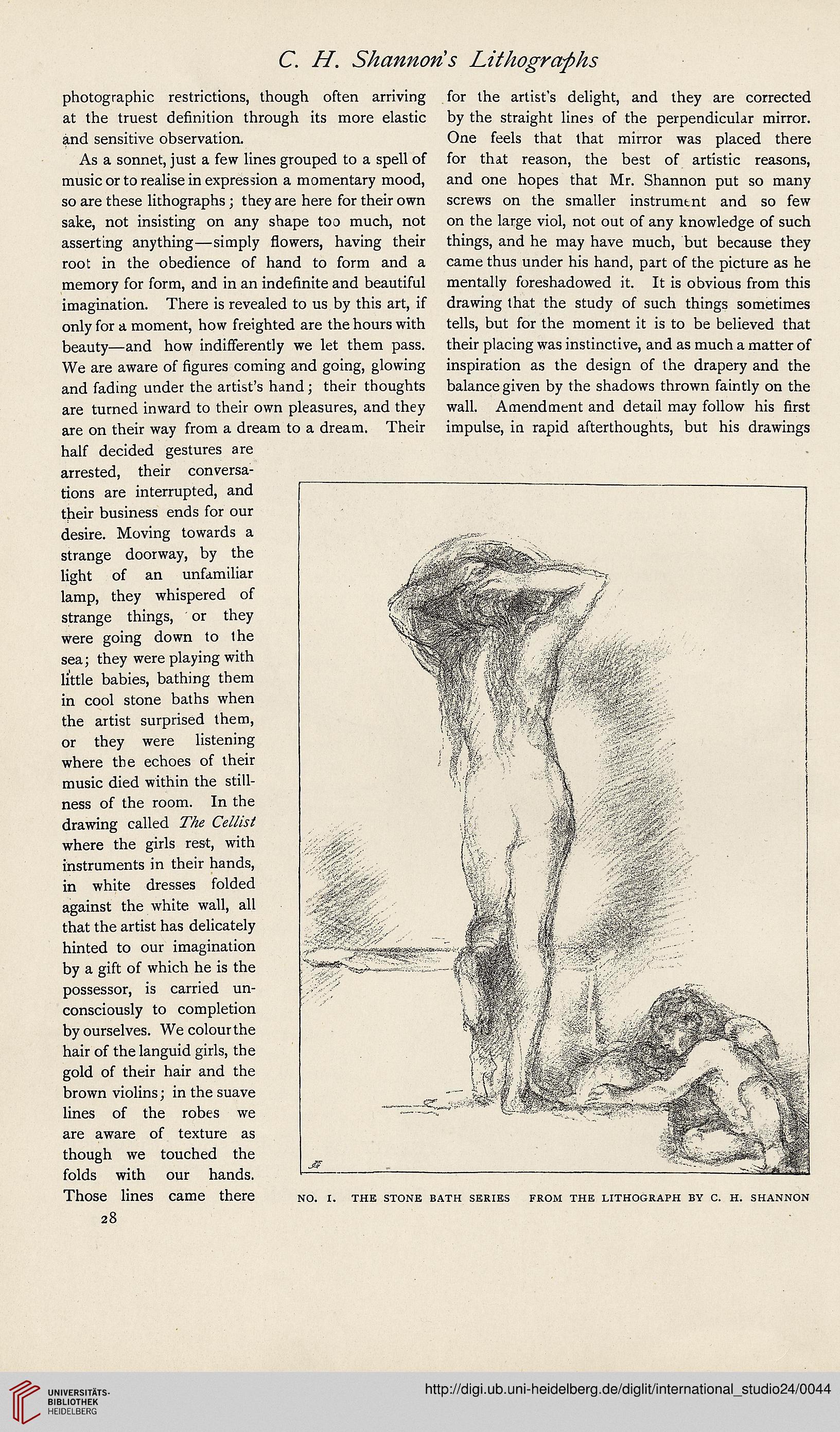C. H. Shannons Lithographs
for the artist’s delight, and they are corrected
by the straight lines of the perpendicular mirror.
One feels that that mirror was placed there
for that reason, the best of artistic reasons,
and one hopes that Mr. Shannon put so many
screws on the smaller instrument and so few
on the large viol, not out of any knowledge of such
things, and he may have much, but because they
came thus under his hand, part of the picture as he
mentally foreshadowed it. It is obvious from this
drawing that the study of such things sometimes
tells, but for the moment it is to be believed that
their placing was instinctive, and as much a matter of
inspiration as the design of the drapery and the
balance given by the shadows thrown faintly on the
wall. Amendment and detail may follow his first
impulse, in rapid afterthoughts, but his drawings
half decided gestures are
arrested, their conversa-
tions are interrupted, and
their business ends for our
desire. Moving towards a
strange doorway, by the
light of an unfamiliar
lamp, they whispered of
strange things, or they
were going down to the
sea; they were playing with
little babies, bathing them
in cool stone baths when
the artist surprised them,
or they were listening
where the echoes of their
music died within the still-
ness of the room. In the
drawing called The Cellist
where the girls rest, with
instruments in their hands,
in white dresses folded
against the white wall, all
that the artist has delicately
hinted to our imagination
by a gift of which he is the
possessor, is carried un-
consciously to completion
by ourselves. We colourthe
hair of the languid girls, the
gold of their hair and the
brown violins; in the suave
lines of the robes we
are aware of texture as
though we touched the
folds with our hands.
Those lines came there
28
photographic restrictions, though often arriving
at the truest definition through its more elastic
and sensitive observation.
As a sonnet, just a few lines grouped to a spell of
music or to realise in expression a momentary mood,
so are these lithographs ; they are here for their own
sake, not insisting on any shape too much, not
asserting anything—simply flowers, having their
root in the obedience of hand to form and a
memory for form, and in an indefinite and beautiful
imagination. There is revealed to us by this art, if
only for a moment, how freighted are the hours with
beauty—and how indifferently we let them pass.
We are aware of figures coming and going, glowing
and fading under the artist’s hand; their thoughts
are turned inward to their own pleasures, and they
are on their way from a dream to a dream. Their
NO. I. THE STONE BATH SERIES FROM THE LITHOGRAPH BY C. H. SHANNON
for the artist’s delight, and they are corrected
by the straight lines of the perpendicular mirror.
One feels that that mirror was placed there
for that reason, the best of artistic reasons,
and one hopes that Mr. Shannon put so many
screws on the smaller instrument and so few
on the large viol, not out of any knowledge of such
things, and he may have much, but because they
came thus under his hand, part of the picture as he
mentally foreshadowed it. It is obvious from this
drawing that the study of such things sometimes
tells, but for the moment it is to be believed that
their placing was instinctive, and as much a matter of
inspiration as the design of the drapery and the
balance given by the shadows thrown faintly on the
wall. Amendment and detail may follow his first
impulse, in rapid afterthoughts, but his drawings
half decided gestures are
arrested, their conversa-
tions are interrupted, and
their business ends for our
desire. Moving towards a
strange doorway, by the
light of an unfamiliar
lamp, they whispered of
strange things, or they
were going down to the
sea; they were playing with
little babies, bathing them
in cool stone baths when
the artist surprised them,
or they were listening
where the echoes of their
music died within the still-
ness of the room. In the
drawing called The Cellist
where the girls rest, with
instruments in their hands,
in white dresses folded
against the white wall, all
that the artist has delicately
hinted to our imagination
by a gift of which he is the
possessor, is carried un-
consciously to completion
by ourselves. We colourthe
hair of the languid girls, the
gold of their hair and the
brown violins; in the suave
lines of the robes we
are aware of texture as
though we touched the
folds with our hands.
Those lines came there
28
photographic restrictions, though often arriving
at the truest definition through its more elastic
and sensitive observation.
As a sonnet, just a few lines grouped to a spell of
music or to realise in expression a momentary mood,
so are these lithographs ; they are here for their own
sake, not insisting on any shape too much, not
asserting anything—simply flowers, having their
root in the obedience of hand to form and a
memory for form, and in an indefinite and beautiful
imagination. There is revealed to us by this art, if
only for a moment, how freighted are the hours with
beauty—and how indifferently we let them pass.
We are aware of figures coming and going, glowing
and fading under the artist’s hand; their thoughts
are turned inward to their own pleasures, and they
are on their way from a dream to a dream. Their
NO. I. THE STONE BATH SERIES FROM THE LITHOGRAPH BY C. H. SHANNON




